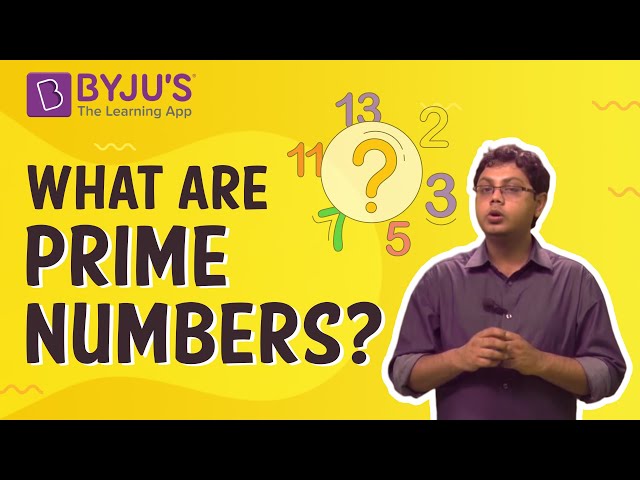The prime numbers questions and answers are provided here for students to understand the concept quickly. Prime Numbers is one of the most basic concepts taught in primary classes. The questions framed are based on the NCERT curriculum. Students can use these questions to take a quick review of the concepts, and become familiar with the topics by practising them. Check your answers against the detailed explanations provided for each question. To learn more about prime numbers, click here.
| Prime Numbers Definition: Prime numbers are those with only two factors, namely 1, and the number itself. Consider the number 7, which contains only two factors: 1 and 7. |
Go through the below prime numbers questions and answers, and practise them as well.
Prime Numbers Questions with Solutions
1. The smallest prime number is _____.
Solution:
The smallest prime number is 2. The number “2” is the only even prime number, which has only two factors, such as 1 and 2.
2. What are the first 10 prime numbers?
Solution:
The first 10 prime numbers are 2, 3, 5, 7, 11, 13, 17, 19, 23, 29.
3. Is 9 a prime number?
Solution:
No, the number 9 is not a prime number.
This is because the number 9 has more than 2 factors. The factors of 9 are 1, 3 and 9. Hence, we can consider 9 as a composite number.
Also, read: Composite Numbers.
4. What is the sum of the first 10 prime numbers?
Solution:
As we know, the first ten prime numbers are 2, 3, 5, 7, 11, 13, 17, 19, 23, 29.
Therefore, sum = 2 + 3 + 5 + 7 + 11 + 13 + 17 + 19 + 23 + 29.
Sum = 129
Hence, the sum of the first ten prime numbers is 129.
5. What is the mean of the first ten prime numbers?
Solution:
First 10 prime numbers = 2, 3, 5, 7, 11, 13, 17, 19, 23, 29.
As we know, Mean = Sum of all values / Total number of values
Mean = 129 / 10
Mean = 12.9
Hence, the mean of the first ten prime numbers is 12.9.
6. What is the median of the first ten prime numbers?
Solution:
As we know,
The first ten prime numbers are 2, 3, 5, 7, 11, 13, 17, 19, 23, 29.
The prime number sequence is already in ascending order.
So, we have 10 terms here.
Therefore, Median = Mean of 5th and 6th term
Here, 5th term = 11 and 6th term = 13.
Median = (11+13)/2 = 24/2 = 12
Hence, the median of the first ten prime numbers is 12.
7. What is the sum of the first seven prime numbers divided by 2?
Solution:
We know that the first seven prime numbers are 2, 3, 5, 7, 11, 13, 17.
Therefore, sum = 2+3+5+7+11+13+17 = 58
When the sum is divided by 2, we get
= 58/2
= 29.
Hence, the sum of the first seven prime numbers divided by 2 is 29.
8. If “p” is the prime number, find the number of factors p2 has.
Solution:
As we know, p2 can be written as the product of p and P. (i.e., p×p). Hence, the factors of p2 are 1, p and p2.
For example, let us take p = 2, the factors of 2 are 1, 2 and 4.
Therefore, p2 has exactly three factors.
9. Identify the twin primes among the given pair of numbers:
(1, 3), (3, 5), (13, 19), (1, 2)
Solution:
As know that the number 1 is neither prime nor composite. Hence, we can ignore the pairs (1, 3) and (1, 2).
As we know, twin prime numbers are the pair of prime numbers with a difference of 2.
Here, (3, 5) is a pair of prime numbers with a difference of 2 (i.e) 5 – 3 = 2.
Whereas (13, 19) is also a pair of prime numbers, in which the difference between them is not equal to 2.
Hence, (3, 5) is a twin prime.
Also, read: What are Twin Primes?
10. How many prime numbers are there between 1 and 50?
Solution:
The list of prime numbers between 1 and 50 are 2, 3, 5, 7, 11, 13, 17, 19, 23, 29, 31, 37, 41, 43, and 47.
Hence, the number of prime numbers between 1 and 50 is 15.
Video Lesson on Prime Numbers

Practice Questions
- What is the sum of the first 20 prime numbers?
- What is the mean of the first 50 prime numbers?
- If “p” is the prime number, find the number of factors p3 has.
- Is 15 a prime number?
- Which is the smallest odd prime number?
Stay tuned to BYJU’S – The Learning App, and learn all Maths-related topics easily by exploring more videos.
Comments